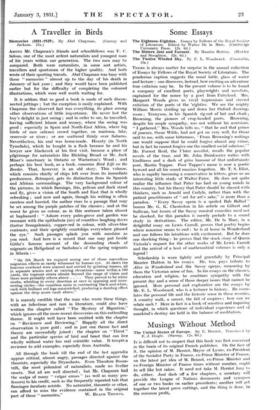A Traveller in Birds
Memories (1851-1929). By Abel Chapman. (Gurney and Jackson. 218.) AMONG Mr. Chapman's friends and schoolfellows was F. C. Selous, one of the most ardent naturalists and youngest man of his years within our generation. The two men may be compared. Both were naturalists, in some sort artists, travellers and sportsmen of the higher quality. And both wrote of their sporting travels. Abel Chapman was busy with these " memories " almost up to the day of his death in January of last year ; and they would have been published earlier but for the difficulty of completing the coloured illustrations, which were well worth waiting for.
It is seldom that so good a book is made of such discon- nected jottings ; but the exception is easily explained. With Chapman the observed fact was everything, its place among other observations of little importance. He never lost the boy's delight in just seeing ; and in order to see, he travelled, having sufficient leisure and money, where the seeing was good : especially in Spain and North-East Africa, where big birds of rare salience crowd together, on marisma, lake, reservoir or. river ; or are scattered thinly over Saharas. Nevertheless, his zeal was home-made. Houxty (in North Tynedale), which he bought in a flash because he and his lawyer saw blackcock at his first visit, became a place of pilgrimage for naturalists like Hickling Broad or Mr. Jack Miner's sanctuary in Ontario or Warterton's Wood ; and perhaps his best book, as a book, concerns Bird Life on the Border. That, however, is an old story. This volume, which consists chiefly of chips left over from its immediate predecessor, Retrospect, gets its distinction from its Spanish and African surroundings. The very background colour of the pictures, in which flamingo, ibis, pelican and duck stand and fly, gives a vision of the South and East that is wholly refreshing ; and now and again, though his writing is often careless and hurried, the author rises to a passage that may be set among the purple patches of the classics ; and at the worst he gives us colour, as in this sentence taken almost at haphazard : " Ashore every palm-grove and garden was resonant with the epithalmia (sic) of countless laughing doves (turtur Senegalensis), copper-red in colour, with silver-blue contrasts, and their sprightly courtships everywhere pleased the eye." Such passages splash you with sunshine as you read. And here is a record that one may put beside Glitke's famous, account of the descending clouds of migrants on Heligoland or Seebohnis of the spring migrants in Siberia :- " On 5th March we enjoyed seeing one of those marvellous migration effects so rarely witnessed by human eye. At dawn the heavens overhead were seamed and serried by gyrating masses, all in separate armies and at varying elevations—some within a 100 yards, 'the topmost strata' almost beyond the range -of -vision and there were probably others above . . . . They proved to be white storks, wheeling in every direction at once in opposing and inter- secting circles--the countless units in contrasting black-and-white, each with brilliant red legs outstretched, producing a dazzling effect against the deep azure vault above."
It is scarcely credible that the man who wrote these things, with an infectious zest rare in literature, could also have written the chapter called " The Mystery of Migration," which ignores all the more recent discoveries on this enthralling theme. It might well have been omitted with the chapter on " Reviewers and Reviewing." Happily all the direct observation is pure gold ; and in just one theme fact and theory are successfully joined : the chapter on " Thirst " and the_ particular species of bird and beast that can live wholly without water has real scientific value. It tempts a reviewer to add examples, especially from Australia.
All through the book till the end of the last appendix appear critical, almost angry, passages directed against the theorists, especially the Liryasdusts. Even Theodore Roose- velt, the most polemical of naturalists, made no livelier onsets. Not all are well directed ; but Mr. Chapman had the scalps of many " vulgar errors (as well as many pro- fessors) to his credit, such as the frequently repeated tale that flamingos incubate astride. No naturalist, theoretic or other, can afford to miss the evidence contained in the original part of these " memories." W. BEACH THOMAS.






































 Previous page
Previous page